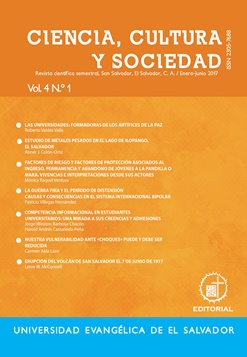Study on heavy metals in Lake Ilopango, El Salvador
DOI:
https://doi.org/10.5377/ccs.v4i1.6020Keywords:
El Salvador, Lake Ilopango, Contaminants.Abstract
Lake Ilopango is located between three departments of El Salvador: San Salvador, Cuscatlán, and La Paz. According to Arévalo & Castañeda (2012), the lake fills aquifers, stores water, controls floods in the region, and offers fishing resources and scenic beauty for tourism and recreation. However, in 2015, the Salvadoran government began the extraction of water from the lake to supply the Salvadoran capital with drinking water (Videla, 2015). For this reason, this study investigated the presence and level of concentration of contaminants as part of a water quality monitoring for human consumption. Simple sampling was done at six points on the lake, indicated as: A, B, C, D, E and F. These samples were analyzed by an inductor of plasma coupled by emission of optical spectroscopy (ICP-OES 3300 XL). The results showed evidence of water pollution by heavy metals such as arsenic (As), beryllium (Be), cadmium (Cd), selenium (Se), thallium (Tl) and lead (Pb). Moreover, these contaminants exceeded the limits allowed for human use and consumption established by the US Environmental Protection Agency (epa).
Revista ciencia, cultura y sociedad Vol. 4 No. 1 enero-junio 2017; 7-14
Downloads
1401
Downloads
Published
How to Cite
Issue
Section
License

This work is licensed under a Creative Commons Attribution-NonCommercial 4.0 International License.
The authors give to the copyright to the journal Ciencia, Cultura and Sociedad, and copyright in all forms and media, to be notified of acceptance of your article. The authors can publish their articles in another journal after a semester published in this volume. The content of the articles is the sole responsibility of the authors. To refer to the articles correctly quote the authors.

Ciencia, Cultura y Sociedad articles are published in open access and are under a Creative Commons Attribution-NonCommercial 4.0 International License.

